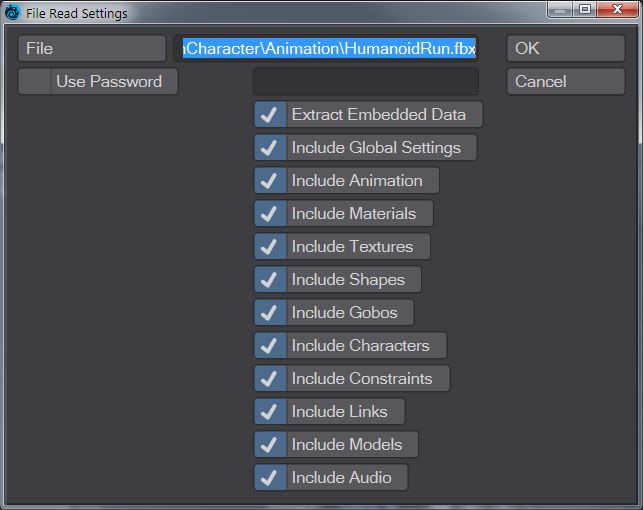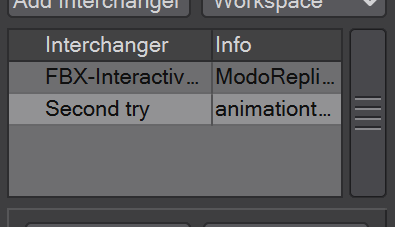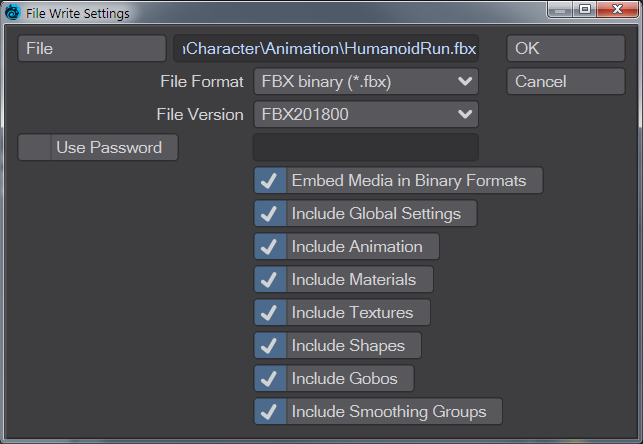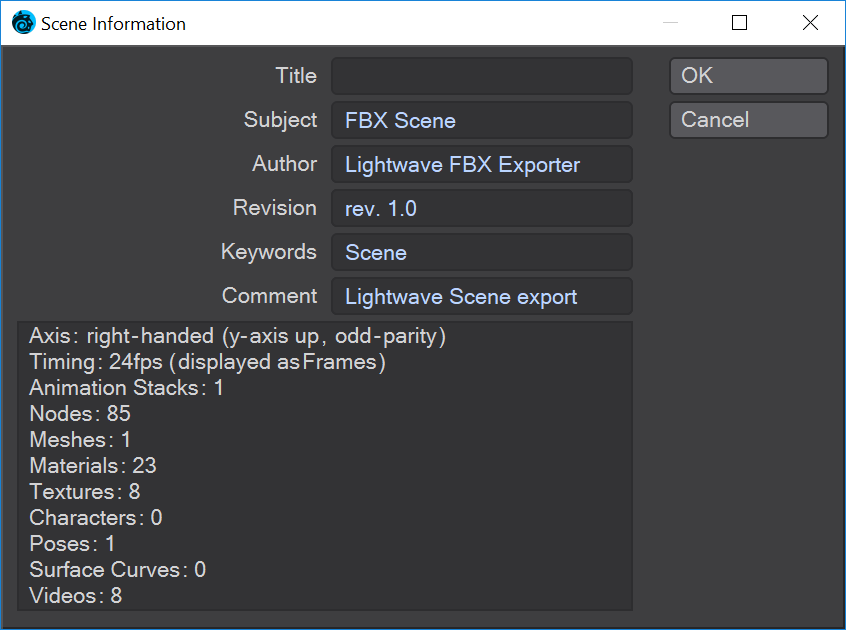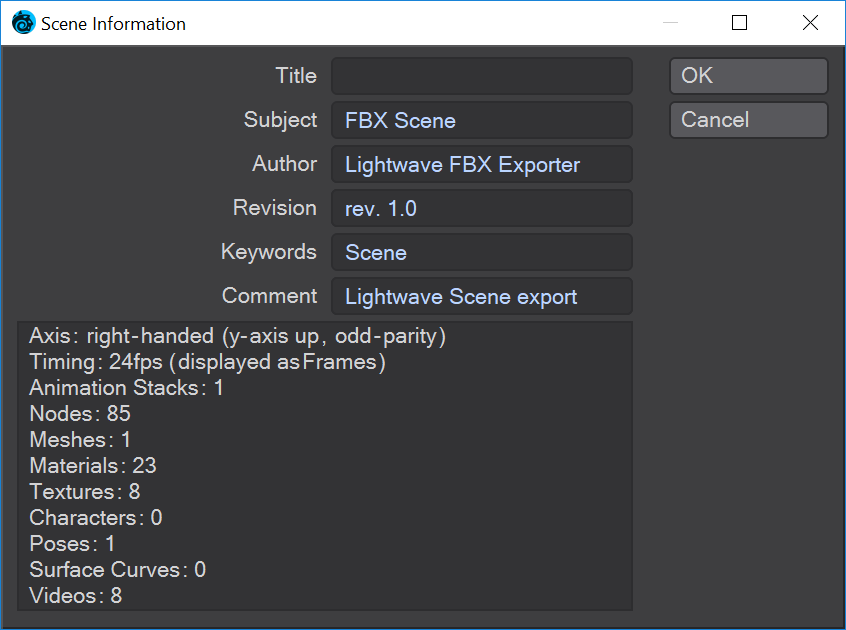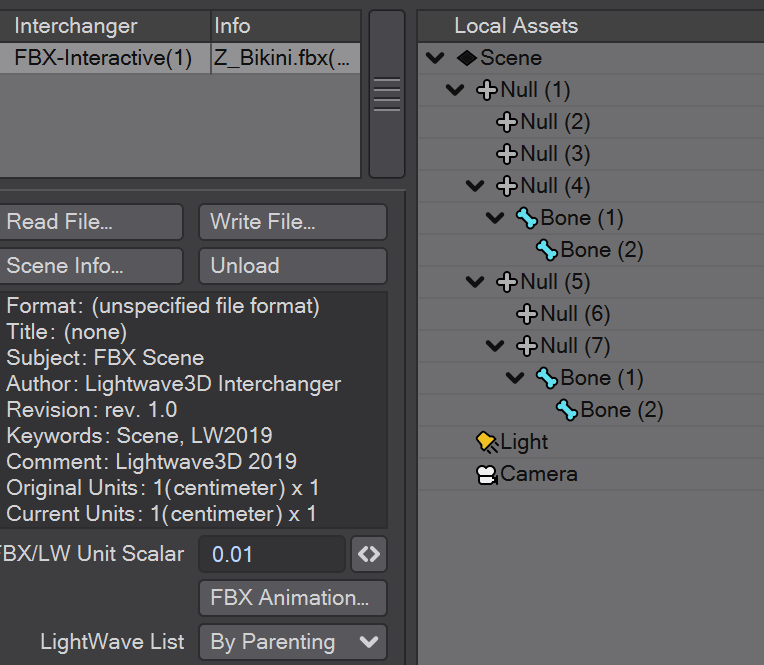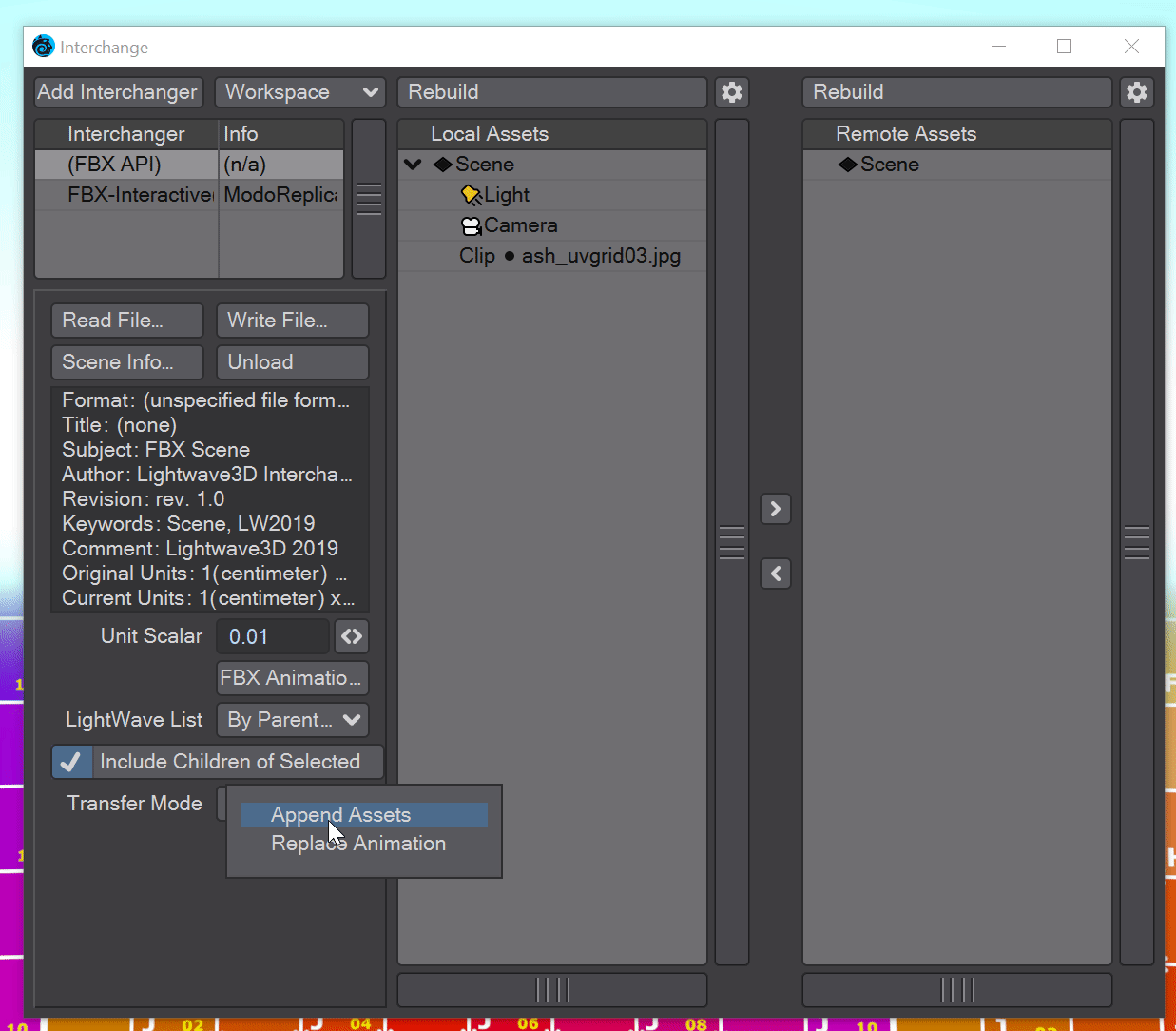Interchange Bridge
The new Interchange Operator window presents two lists. The left list, or local, shows the current LightWave scene content. The right side - remote - is the FBX file currently loaded.
It is best to use the existing FBX Export right now. The Interchange Bridge works well for importing, less so for exporting in this initial implementation.
Introduction
LightWave 2019 introduces the new Interchange Bridge for better importation and exportation of assets. An interchanger is the interface between files created in other applications and LightWave. For the moment, the only interchanger is FBX, and it will be loaded. The Interchange Bridge is divided into three columns. On the left are general options and info, the middle section concerns items local to LightWave already in the current scene. The right section contains loaded FBX files brought in with the Read File button in the left column.
First Use
When you first open the Interchange Bridge panel, click on the Read File... button to add an FBX file to the right column headed Remote Assets. This will show the following window:
where you can choose the options for the FBX file you have chosen. Clicking on OK will add the FBX file to the right column headed Remote Assets. To add the whole thing to LightWave (either Layout or Modeler) drag the topmost Scene entry to the column headed Local Assets. Alternatively, click the left-pointing arrow between the Local and Remote columns. If you only want a specific part from the FBX file just drag the corresponding item. Whatever you have dragged should appear in the Layout or Modeler viewport(s) immediately (depending on the size of the asset).
Left Column
At the top of the leftmost column are:
- Add Interchanger - Adds an additional FBX interchanger to allow for multiple FBX files on the same bridge. Useful for when you want to mix and match FBX file contents. You can have several interchangers active
- Workspace - Tools to deal with the workspaces set by Interchangers. There are three options in the dropdown:
- Reset - After a warning will reset the Interchanger window to its initial view with no interchangers
- Save... - Saves workspace for later retrieval
- Load... - Loads saved workspaces
Down the left side of the window are:
- The Interchanger workspace:
Interchangers can be right-clicked to rename or remove them
Read File... - This is where to choose an initial FBX file to import. Once determined, the following window appears, where you can select the options you want to include from the FBX file chosen:
Although there are many options listed here, LightWave does not currently understand or implement them all. However, if they are read from the FBX file to memory, they can be written back out. They are not represented by any assets in the GUI and can not be transferred back and forthIt is important to note the following
- FBX has a concept of item position separate from the animation of the item.
- FBX has a concept of poses, which store positions of item.
- FBX has a concept of skin cluster binding, which can be separate from poses and animation and non-animated position.
Layout only has one concept, the animation
Frames less than zero to support these FBX concepts that Layout does not support directly.
- Frame -1: the binding position (applicable when skin clusters are used)
- Frame -2: the not-animated position (can be same as Frame 0, but may differ)
- Frames < -2: poses (if any); each pose on a different frame.
- Write File... - This is for exporting your scene in the Interchanger format, here FBX. When you click this button, a settings window appears where you can finetune your FBX export.
Although the number of options is smaller for writing out FBX files, the FBX API dictates the choices. Options read in will be written out - Scene Info... - Opens a window to input the LightWave (local) scene information in the FBX file for export
- Unload - Unloads the FBX file from the scene. It is still shown in the Interchanger lister, and the FBX files will still be on disk
- Scene Info - Technical details about the FBX file's content
- Active Take / Active Layer - FBX files can contain several "Takes," different animations, and each take can include several layers that can be mixed and layered, much like LightWave's Motion Mixer. Only one Take, with one layer, can be active at any one time in LightWave.
The Flatten Layers button here will collapse animation layers down to the selected take. Other layers are lost when the file is written out but can be reclaimed up to that point by reloading the FBX file with the Read File... button. Animation layers can be added to the stack as needed - LightWave List - Group the left lister in one of two ways:
- By Parenting - The standard LightWave hierarchical view
- By Ownership - In LightWave, the scene is always the owner of all scene items - Lights, Cameras, Objects. Objects are the owners of bones.
- By Parenting - The standard LightWave hierarchical view
- Include Children of Selected - This toggle (that defaults to on) means you don't need to explicit select all the elements of a scene to import or export, just the parents of hierarchies - the scene entry, for instance, would transfer the scene setup plus all the objects, lights and cameras
Local Column
Hit Rebuild to update changes
The middle column contains a view of your current LightWave scene. You can copy elements from your external file into this column piecemeal or load an FBX wholesale to add to a new scene.
Local Options
The Reset button at the top of this window will reset to the initial default settings shipped with LightWave, but you can use Set Defaults to create a local set of personal defaults when opening the Local Options panel each scene. Once set, further changes made can be reverted by hitting the Get Defaults button. Animation keyframes can be preserved or baked (so that each frame has a key). The Options panels both have Layout and Modeler tabs, but Local Options has no Modeler settings.
Transfer
Two Transfer arrows between the listers will transfer the selected items from one lister to the other. If nothing is selected, the entire contents of a lister will be copied over. Equally, with the Include Children of Selected toggle checked, clicking on the Scene name will transfer the entire lister contents over. Items can be transferred by double-clicking on them.
As of 2019.1, you can now drag and drop between the local and remote columns.
Transfer only animations
The Interchange panel now has two options for the Transfer Mode. You can either Append Assets or Replace Animation. Append Assets was the default functionality from before, but Replace Animation is new and can be used to transfer animation over items that are already animated. In this way, it can serve as an undo or an easy way to copy animations to multiple items.
Remote Column
Hit Rebuild to update changes
The remote column contains assets in the target format, for now just FBX. You can add items from one or more local scenes to a single FBX file, which will be written to disk once the Write File... button is clicked. Multiple Interchangers can be added, and each has its own remote display chosen by clicking on the integrator in the Workspace area of the panel.
You can now specify that remote assets will be brought in with Standard or PBSF materials with the Use Standard Material option (on by default). The surfaces will now be created similarly to the Surface Editor's Convert > Layered to Principled option. Images linked to a surface will be recreated using the Layered nodes.
Remote Options
The Import Options panel contains settings for writing to FBX files. Again, user Defaults can be set, and this time the Modeler tab has further options relating to how objects will be treated when exported to FBX.


